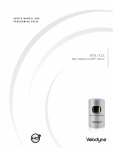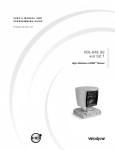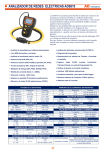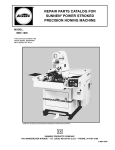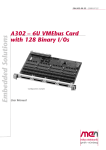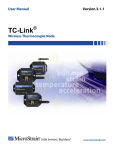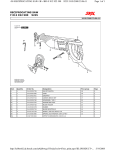Download VLP-16 Users Manual
Transcript
USER‘S MANUAL AND PROGRAMMING GUIDE VLP-16 Velodyne LiDAR Puck TABLE OF CONTENTS i SAFETY NOTICES 1 INTRODUCTION 2 PRINCIPLES OF OPERATION 3 Calibrated Reflectivities 4 Return Modes 7 SETUP 7 Case Contents 7 Mounting 8 Connections 8 Power 8 Ethernet 9 GPS 10 USAGE 10 Using the Sensor 12 SENSOR DATA 12 Data Packet Format 16 Time Stamp 16 Time Stamping Accuracy 16 Factory Bytes 17 The Position Packet 19 TROUBLESHOOTING 19 Service and Maintenance 20 SPECIFICATIONS 21 APPENDIX A Packet Structure & Timing 29 APPENDIX B Interface Box 34 APPENDIX C Webserver GUI 35 APPENDIX D Firmware Update Procedure 43 APPENDIX E VeloView 44 APPENDIX F Mechanical Drawing VLP-16 USER’S MANUAL SAFETY NOTICES VLP-16 USER’S MANUAL Caution To reduce the risk of electric shock and to avoid violating the warranty, do not open sensor body. Refer servicing to qualified service personnel. The lightning flash with arrowhead symbol is intended to alert the user to the presence of uninsulated “dangerous voltage” within the product’s enclosure that may be of sufficient magnitude to constitute a risk of electric shock to persons. The exclamation point symbol is intended to alert the user to the presence of important operating and maintenance (servicing) instructions in the literature accompanying the product. 1. 2. 3. 4. 5. Read Instructions – All safety and operating instructions should be read before the product is operated. Retain Instructions – The safety and operating instructions should be retained for future reference. Heed Warnings – All warnings on the product and in the operating instructions should be adhered to. Follow Instructions – All operating and use instructions should be followed. Servicing – The user should not attempt to service the product beyond what is described in the operating instructions. All other servicing should be referred to Velodyne. Complies with IEC 60825-1 CAUTION Use of controls or adjustments or performance of procedures other than those specified herein may result in hazardous radiation exposure i INTRODUCTION VLP-16 USER’S MANUAL Congratulations on your purchase of a Velodyne VLP-16 Real-Time 3D LiDAR Sensor. This sensor provides state-ofthe-art 3D imaging in real time. This manual describes how to set up and operate the VLP-16. It covers installation and wiring, output packet format and interpretation, and GPS installation notes. This manual is undergoing constant revision and improvement – check www.velodynelidar.com for updates. 1 PRINCIPLES OF OPERATION VLP-16 USER’S MANUAL The VLP-16 creates 360º 3D images by using 16 laser/detector pairs mounted in a compact housing. The housing rapidly spins to scan the surrounding environment. The lasers fire thousands of times per second, providing a rich, 3D point cloud in real time. Advanced digital signal processing and waveform analysis provide high accuracy, extended distance sensing, and calibrated reflectivity data. Unique features include: • Horizontal Field of View (FOV) of 360° • Rotational speed of 5-20 rotations per second (adjustable) • Vertical Field of View (FOV) of 30° • Returns of up to 100 meters (useful range depends on application) Figure 1. Overview of the LiDAR VLP-16 3D Imaging System 2 PRINCIPLES OF OPERATION VLP-16 USER’S MANUAL Calibrated Reflectivities The VLP-16 measures the reflectivity of an object with 256-bit resolution independent of laser power and distance over a range from 1m to 100m. Commercially available reflectivity standards and retro-reflectors are used for the absolute calibration of the reflectivity, which is stored in a calibration table within the FPGA of the VLP-16. • • Diffuse reflectors report values from 0-100 for reflectivities from 0% to 100%. Retro-reflectors report values from 101 to 255 with 255 being the reported reflectivity for an ideal retroreflector and 101-254 being the reported reflectivity for partially obstructed or imperfect retro-reflectors. Diffuse Reflector Black, absorbent diffuse reflector (value 0) White, reflective diffuse reflector (value 100) Retro-Reflector: Retro-reflector covered with semitransparent white surface (value 101) Retro-reflector without any coverage (value 255) Figure 2. Reflector Types 3 PRINCIPLES OF OPERATION VLP-16 USER’S MANUAL Return Modes Due to the laser’s beam divergence, a single laser firing often hits multiple objects producing multiple returns. The VLP-16 analyzes multiple returns and reports either the strongest return, the last return, or both returns. In the illustration below, the majority of the beam hits the near wall while the remainder of the beam hits the far wall. The VLP-16 will record both returns only if the distance between the two objects is greater than 1m. In the event that the strongest return is the last return, the second-strongest return is reported. Figure 3. Return Modes The dual return function is often used in forestry applications where the user needs to determine the height of the trees. The figure below illustrates what happens when the laser spot hits the outer canopy, penetrates the leaves and branches, and eventually hits the ground. Figure 4a. Dual Returns Example 1 4 PRINCIPLES OF OPERATION VLP-16 USER’S MANUAL VeloView is able to display dual return data. Figure 4b below has two good examples of dual return data. In this test area, the VLP-16 gets returns from the vinyl weather curtain (see inserted image) as well as from objects inside the building. Additionally, you can see where the beam is split on the edge of the loading dock. The blue lines indicate the portion of the beam that hit the loading dock while the red lines indicate the portion of the beam that hit the ground beyond the loading dock. Figure 4b. Dual Returns Example 2 In dual return mode, the data rate of the sensor doubles. Data rates for the two modes are given below: Mode Packets/Second Megabits/Second Strongest 754 ~ 8 Last 754 ~ 8 Dual 1508 ~ 16 Table 1. Dual Return Data Rates 5 PRINCIPLES OF OPERATION VLP-16 USER’S MANUAL The return mode is selected in the webserver user interface (Appendix C). In the screenshot below the Strongest return is selected. The other options are Last and Dual. Figure 5. Selecting Return Type 6 SETUP VLP-16 USER’S MANUAL This section describes the usual standard set up of the sensor assuming you are connecting the sensor to a standard computer or laptop and mounting the sensor on a vehicle. For other connections and mounting locations, please contact Velodyne for technical assistance. A video showing the set-up of the VLP-16 in an office environment is available at: https://www.youtube.com/watch?v=wUfHadExvs8 The standard setup involves: 1. Unpacking the shipping case contents. 2. Securely mounting the sensor to a vehicle or other scanning platform. 3. Connecting power to the sensor. 4. Connecting the sensor’s data output to the computer. Case Contents The shipping case contains: • VLP-16 sensor unit with ~3 meter cable terminated at an interface box • Desktop AC/DC power adapter (North American plug) • 6’ AC cord • Ethernet cable (1 meter) • USB memory stick with: o User manual (check www.velodynelidar.com for updates) o Sample data sets and miscellaneous documents o VeloView (free, open source viewing and recording software) Mounting The sensor base provides one ¼-20 threaded, 9/32” deep mounting hole and two precision locating holes for dowel pins. The sensor can be mounted at any angle/orientation. • The unit is weatherproofed to withstand wind, rain and other adverse weather conditions. Refer to the specifications page for operational and storage temperature ranges. • Be sure the unit is mounted securely to withstand vibration and shock without risk of detachment. The unit does not need shock proofing. The unit is designed to withstand automotive G-forces; (500 m/sec2 amplitude, 11 msec duration shock and 3G rms 5 Hz to 2000 Hz vibration). Figure 6. VLP-16 Base 7 SETUP VLP-16 USER’S MANUAL Connections The VLP-16 comes with an integral cable that is terminated at an interface box. The cable is approximately 3 meters (10’) in length and is permanently attached at the sensor, but it may be removed from the interface box for ease of cable routing, direct wiring, and/or inserting in-line connector(s). The interface box provides connections for power, Ethernet, and GPS inputs. For more information on the interface box, see Appendix B. Power The 2.1 mm barrel plug jack fits in the included AC/DC power adapter. The center pin is positive polarity. Note: The VLP-16 does not have a power switch. It spins and operates approximately 5s after power has been applied. The VLP-16 requires 8 watts of power and is commonly used in vehicle applications where standard 12 volt, 2 amp power is readily available. 1. 2. Connect the interface box. Connect to the Ethernet port of any standard computer. Note: Before operating the sensor, make sure that: • The sensor is securely mounted • Power is applied in the correct polarity Ethernet The standard RJ45 Ethernet connector connects to any standard computer. IP Address: The IP address for each VLP-16 is set at the factory to 192.168.1.201, but can be changed by the user via the WebServer GUI. For details on how to connect to the webserver GUI, see Appendix C. MAC address: Each VLP-16 has a unique MAC address that is defined by Velodyne and cannot be changed. Serial Number: Each VLP-16 has a unique serial number that is defined by Velodyne and cannot be changed. Note: The VLP-16 is only compatible with network cards that have either MDI or AUTO MDIX capability. 8 SETUP VLP-16 USER’S MANUAL GPS The VLP-16 can synchronize its data with precision, GPS-supplied time pulses enabling users to determine the exact firing time of each laser. External synchronization requires a user supplied GPS receiver generating a synchronization Pulse Per Second (PPS) signal and a NMEA $GPRMC message (Appendix B). The $GPRMC message provides minutes and seconds in Coordinated Universal Time. Upon synchronization, the sensor will read the minutes and seconds from the $GPRMC message and use that to set the sensor’s time stamp to the number of microseconds past the hour per UTC time. Synchronizing the VLP-16’s timestamps to UTC allows third party software to easily geo-reference the LiDAR data into a point cloud. GPS Receiver Option 1: User Supplied GPS Receiver The user must configure their GPS device to issue a once-a-second synchronization pulse (PPS, 0-5V, rising edge), typically output over a dedicated wire, and issue a once-a-second NMEA standard $GPRMC sentence. No other output message from the GPS will be accepted by the VLP-16. Note: The $GPRMC sentence can be configured for either hhmmss format or hhmmss.s format. The GPS signals can be wired directly to the screw-terminal inside the interface box. If you wish to wire your own GPS receiver, unscrew the top of the interface box and refer to the labeled screw terminal connector on the circuit card (Appendix B). GPS Receiver Option 2: Velodyne Supplied GPS Receiver A consumer grade Garmin GPS receiver that is pre-programmed by Velodyne is available for purchase by VLP-16 users. This receiver is pre-wired with a connector that plugs into the VLP-16 interface box, and it is pre-programmed to output the correct $GPRMC sentence and PPS synchronization pulse. Contact Velodyne for current pricing and order part number “92-GPS18LVC.” Figure 7. Interface Box 9 USAGE VLP-16 USER’S MANUAL Using the Sensor The VLP-16 sensor needs no configuration, calibration, or other setup to begin producing usable data. Once the unit is mounted and wired, supplying power initiates scanning and the delivery of data. The quickest way to watch the VLP-16 in action is to use VeloView, the open-source viewer software (https://github.com/Kitware/VeloView) included with the unit. VeloView reads the packets from the VLP-16 via the Ethernet connection, performs the necessary calculations to determine point locations, then plots the points in 3D on the viewer’s computer. This is the recommended starting point for new users. You can observe both distance and intensity data through VeloView. For more information on VeloView, see Appendix E. Most users will elect to create their own application-specific point cloud tracking and plotting and/or storage scheme. There are several fundamental steps to this process: 1. 2. 3. 4. Establish communication with the VLP-16 Parse the data packets for rotational angle, measured distance, and reported calibrated reflectivities Calculate X, Y, Z coordinates from reported rotational angle, measured distance, and vertical angle dependent on laser ID Plot or store the data as needed Each of these steps is described in detail below: 1. Establish communication with the VLP-16. The VLP-16 outputs two separate broadcast UDP packets. By using a network monitoring tool such as Wireshark (https://www.wireshark.org/download.html) you can capture and observe the packets as they are generated by the unit. 2. Parse the data packets for rotational angle, measured distance, and reported calibrated reflectivities. Your software needs to read the data packet from the Ethernet port, and extract the azimuth, elevation angle, distance to the object, and time stamp. Once the data is identified, proceed to the next step. See Data Packet Format in Appendix A. 3. Calculate X, Y, Z coordinates from reported data. The VLP-16 reports coordinates in spherical coordinates (r, ω, α). Consequently, a transformation is necessary to convert to XYZ coordinates. The vertical/elevation angle (ω) is fixed and is given by the Laser ID (Appendix A). The position of the return in the data packet indicates the Laser ID. The horizontal angle/azimuth (α) is reported at the beginning of every other firing sequence, and the distance is reported in the two distance bytes. With this information X, Y, Z coordinates can be calculated for each measured point. Points with distances less than one meter should be ignored. The conversion is shown in Figure 8 on the following page. 10 USAGE VLP-16 USER’S MANUAL Figure 8. Spherical to XYZ Conversion 4. Plot or store the data as needed The calculated X, Y, Z data is typically stored for later processing and/or it is displayed on a computer as a series of point clouds. Note: The VLP-16 has the capability to synchronize its data with GPS precision time via a Pulse Per Second (PPS) signal from a GPS receiver. A synchronized timestamp from the VLP-16 sensor may be used to match the data stream from the sensor with the data stream from the attached external GPS receiver and/or Inertial Measurement Unit (IMU). 11 SENSOR DATA VLP-16 USER’S MANUAL Data Packet Format The VLP-16 outputs two types of UDP Ethernet packets: Data Packets and Position Packets. The Data Packet is comprised of the laser return values, calibrated reflectivity values, azimuth values, a time stamp, and two factory bytes indicating the sensor model and the return mode (Strongest, Last, and Dual). The data packet is 1248 bytes long and is sent on port 2368. Each VLP-16 data packet consists of a 42 byte header and a 1206 byte payload containing twelve blocks of 100-byte data records. The data is followed by a four-byte time stamp data and two factory bytes. The data packet is then combined with status and header data in a UDP packet and transmitted over the Ethernet. The firing data is assembled into the packets in the firing order, with multi-byte values - azimuth, distance, timestamp - transmitted least significant byte first. The basic form of the data packet is shown below. Figure 9a. Data Packet Each data block begins with a two-byte start identifier “FF EE”, then a two-byte azimuth value (rotational angle), followed by 32x 3-byte data records. Azimuth Value The reported azimuth is associated with the first laser shot in each collection of 16 laser shots. However, only every other encoder angle is reported for alternate firing sequences. The user can choose to interpolate that missing encoder stamp (see Appendix A). 12 SENSOR DATA VLP-16 USER’S MANUAL Valid values for the azimuth range from 0° to 359.99° For example, in Figure 10a on page the following page, the second azimuth calculation for the second data block would be: 1) Get Azimuth Values: 0x33 & 0x71 2) Reverse the bytes: 0x71 & 0x33 3) Combine the bytes into a two-byte, unsigned integer: 0x7133 4) Convert to decimal: 28,979 5) Divide by 100 6) Result: 289.79° Hence value of the azimuth for the first laser firing the second data block is 289.79° Note: The zero degree position on the sensor is directly opposite the cable connection (Appendix F). Data Record Each three-byte data record consists of two distance bytes and a calibrated reflectivity byte. Figure 9b. Data Record The distance and reflectivity data are collected in the same staggered order in which the lasers are fired. (see Appendix A). Distance to an object is reported in the first two of the three bytes in a data record. The Calibrated Reflectivity value is reported in the third of the three bytes. The distance is reported to the nearest 2.0mm, meaning that the unsigned integer value given by the two distance bytes needs to be multiplied by 2.0mm to calculate the absolute distance to the object. The Calibrated Reflectivity value is defined on a scale from 0-255. Refer to the Calibrated Reflectivities section on page 3 for further details. 13 SENSOR DATA VLP-16 USER’S MANUAL Below is the first part of a sample packet as displayed in Wireshark. Figure 10a. Sample Packet 1 14 SENSOR DATA VLP-16 USER’S MANUAL Below is the last part of a sample packet as displayed in Wireshark. Calculation of the timestamp and interpretation of the Factory Bytes are shown. Figure 10b. Sample Packet 2 For further information regarding the packet structure see Appendix A. 15 SENSOR DATA VLP-16 USER’S MANUAL Time Stamp The four-byte time stamp is a 32-bit unsigned integer. This value represents microseconds from the top of the hour to the first laser firing in the packet. The number ranges from 0 to 3600x106 µs (the number of microseconds in one hour). The time stamp represents the time of the first shot of the first firing sequence. The time stamp, like the reported distance, are transmitted least significant byte first. All sixteen lasers are fired and recharged every 55.296µs. The cycle time between firings is 2.304µs. There are 16 firings (16 x 2.304µs) followed by a recharge period of 18.43µs. Therefore, the timing cycle to fire and recharge 16 lasers is given by ((16 x 2.304µs) + (1 x 18.43µs)) = 55.296µs There are 24 of these 16-laser firing groups per packet, hence, it takes 1.33ms to accumulate one data packet. This implies a data rate of 754 data packets/second (1/1.33ms). The GPS timestamp feature is used to determine the exact firing time for each laser. This allows users to properly time-align the VLP-16 data points with the pitch, roll, yaw, latitude, longitude, and altitude data from a GPS/Inertial measurement system. Time Stamping Accuracy The following rules and subsequent accuracy apply for GPS time stamping. 1. 2. When the VLP-16 powers up it runs on its own internal clock, and it begins issuing timestamps in microseconds beginning from zero. Expect a drift of about 5 seconds per day under this method. When a GPS is connected and synchronized, the NMEA $GPRMC sentence is reported in the position packet as described in Appendix B. GPS time synching runs in one of two modes: a. b. When the GPS achieves lock. The VLP-16 clock will then be within +/-50ps of the correct time at all times. The timestamp reported will be in microseconds past the hour based on the current UTC provided by the GPS. Some GPS receivers have a battery back up and will continue to supply a time code for some period (hours, days, or weeks). In this instance the accuracy is as good as the back up clock in the GPS. If the GPS is disconnected after synchronization the VLP-16 will continue to run its own clock and be subject to a drift of approximately 5 seconds per day. Factory Bytes Every VLP-16 data packet, beginning with firmware version 3.0.23, identifies the type of sensor from which the packet came and the return mode (Strongest, Last, Dual). The return mode determines how the packet should be interpreted. See Figure 10b on the previous page. Value 37h 38h 39h Field 4DEh Meaning Strongest Return Last Return Dual Return Field 4DFh Value Meaning 21h HDL-32E 22h VLP-16 Table 2. Factory Byte 16 SENSOR DATA VLP-16 USER’S MANUAL The Position Packet The position packet is provided so the user can verify that the VLP-16 is receiving valid time updates from a GPS receiver. The position packet is a 554 byte long UDP packet broadcasted on port 8308. It consists of: 42 byte Ethernet header 198 bytes Unused 4 bytes Timestamp 4 bytes Unused 72 byte NMEA $GPRMC sentence 234 bytes Unused Table 3. Position Packet An example $GPRMC message is shown below: $GPRMC,220516,A,5133.82,N,00042.24,W,173.8,231.8,130694,004.2,W*70 1 2 3 4 5 6 7 8 9 10 11 12 1 2 3 4 5 6 7 8 9 10 11 12 220516 A 5133.82 N 00042.24 W 173.8 231.8 130694 004.2 W *70 Time Stamp validity - A-ok, V-invalid current Latitude North/South current Longitude East/West Speed in knots True course Date Stamp Variation East/West checksum The position packet returns the exact same $GPRMC message that was received from the GPS via the serial connection. Note: The Validity field in the $GPRMC message (‘A’ or ‘V’) should be checked by the user to ensure the GPS system and the VLP-16 are receiving valid Coordinated Universal Time (UTC) updates from the user’s GPS receiver. Providing timestamps in UTC allows third party software to geo-reference the LiDAR data into a point cloud. Upon synchronization, the sensor will read the minutes and seconds from the $GPRMC message and use that to set the sensor’s time stamp to the number of microseconds past the hour per UTC time. 17 SENSOR DATA VLP-16 USER’S MANUAL Figure 11. Position Packet 18 TROUBLESHOOTING VLP-16 USER’S MANUAL Use this chart to troubleshoot common problems with the VLP-16. Problem Resolution Unit doesn’t spin Verify power connection and polarity. Verify proper voltage — should be between 9 and 32 volts drawing a minimum of one amp. Inspect the fuse in the interface module. Replace if necessary (3 Amp automotive fuse). Unit spins but no data Verify Ethernet wiring. Verify packet output using another application (e.g. Ethereall/Wireshark). Verify receiving computer’s network settings. Set a static IP address in your computer’s network settings. 192.168.1.77 Verify that no security software has been installed which may block Ethernet broadcasts. Table 4. Troubleshooting Service and Maintenance There are no user serviceable nor maintenance requirements or procedures for the Velodyne VLP-16. Opening the sensor will void the warranty. For service or maintenance, please contact Velodyne at +1 (408) 465-2800, or log on to our website at www.velodynelidar.com 19 SPECIFICATIONS VLP-16 USER’S MANUAL Sensor: • Time of flight distance measurement with calibrated reflectivities • 16 channels • Measurement range up to 100 meters • Accuracy +/- 3 cm (typical) • Dual returns • Field of view (vertical): 30° (+15° to -15°) • Angular resolution (vertical): 2° • Field of view (horizontal/azimuth): 360° • Angular resolution (horizontal/azimuth): 0.1º - 0.4º • Rotation rates: 5 - 20 Hz • Integrated web server for easy monitoring and configuration • Max altitude of operation 200 meters Laser: • Class 1 - eye safe • 903 nm wavelength Mechanical/ Electrical/ Operational: Output: Wave Length Pulse Duration/ Repetition Rate Maximum Power/ Energy Output • Power consumption: 8 W (typical) • Operating voltage: 9 - 32 VDC (with interface box and regulated power supply) • Weight: 830 grams (without cabling) • Dimensions: 103 mm diameter x 72 mm height • Shock: 500 m/sec2 amplitude, 11 msec duration • Vibration: 5 Hz to 2000 Hz, 3G rms • Environmental Protection: IP67 • Operating temperature -10° to + 60° C • Storage temperature -40° to +105° C • Up to 0.3 million points/second • 100 Mbps Ethernet Connection • UDP packets containing - Distances - Calibrated relectivities - Rotation angles - Synchronized time stamps (µs resolution) • $GPRMC NMEA sentence from GPS receiver (GPS not included) • 903 nm (min/max range is 896/910 nm) • 6 ns (duration) • 1.44µs * 16 lasers per pattern for a period of 46.1 µs = 21.7KHz (repetition) •31 Watt (0.19 uJ) Table 5. Specifications 20 APPENDIX A: PACKET STRUCTURE & TIMING VLP-16 USER’S MANUAL Definitions Firing Sequence The time and/or process of cycle-firing all the lasers in a VLP-16. It takes 55.296 uSec to fire all 16 Lasers. Laser Channel A single 905nm Laser emitter and detector pair. Each laser channel is fixed at a particular elevation angle relative to the horizontal plane of the sensor. Each laser channel is given its own Laser ID number as shown in Table 6. The elevation angle of a particular laser channel is given by its location in the data packet. Data Point A data point is represented in the packet by three bytes - two bytes of distance and one byte of Calibrated Reflectivity. Data Block A data block is 100 bytes of data and consists of: A two-byte flag (xFFEE), a two-byte azimuth, and 32 Data Points. [100 = 2 + 2 + 32*3]. There are 12 data blocks in a packet, but for calculating time offsets it’s recommended they be numbered 0-11. Data Packet (1248 Bytes) A data packet is 1248 bytes and consists of 42 bytes of header, twelve Data Blocks, a four-byte timestamp, and a two-byte factory field. Return Modes (three choices) The VLP-16 can be set to report either the strongest (by light energy) return, the last (temporally) default or both the strongest and last. If the strongest return is also the last return, then the second-strongest return is reported. The information from two Firing Sequences of 16 lasers is contained in one Data Block. Each packet contains the data from 24 firing sequences. Only one Azimuth is returned per Data Block. See Figure 12 on the following page. Laser ID Vertical Angle 0 -15° 1 1° 2 -13° 3 -3° 4 -11° 5 5° 6 -9° 7 7° 8 -7° 9 9° 10 -5° 11 11° 12 -3° 13 13° 14 -1° 15 15° Table 6. Laser ID 21 APPENDIX A: PACKET STRUCTURE & TIMING Figure 12. Data Block Structure (Single Return Mode) 22 VLP-16 USER’S MANUAL APPENDIX A: PACKET STRUCTURE & TIMING VLP-16 USER’S MANUAL Figure 13. Factory Bytes Beginning with firmware version 3.0.23, the factory bytes are used to indicate the current return mode and the sensor model that delivered the packet. The addition of these fields allows the processing software to automatically determine the sensor type and return mode. Field 4DEh Field 4DFh Value Meaning Value Meaning 37h Strongest Return 21h HDL-32E 38h Last Return 22h VLP-16 39h Dual Return Table 2. Factory Byte 23 APPENDIX A: PACKET STRUCTURE & TIMING Figure 14. Data Block Structure (Dual Return Mode) 24 VLP-16 USER’S MANUAL APPENDIX A: PACKET STRUCTURE & TIMING VLP-16 USER’S MANUAL Azimuth Interpolation Because the VLP-16 reports the azimuth value for every-other firing sequence it’s helpful to interpolate the un-reported azimuth. There are several ways to interpolate the un-reported azimuth, but the one given below is simple and straight forward. Consider a single data packet. The time between the first firing of the first set of sixteen firings (Data Block 1) and the first firing of the third set of sixteen laser firings (Data Block 2) is ~110.6µs. If you assume the rotation speed over that short interval is constant, you can assume the azimuth of the (N+1) set of sixteen laser firings is halfway between the azimuth reported with the Nth set of 16 laser firings and the azimuth reported with the (N+2) set of laser firings. Below is pseudo-code that performs the interpolation. The code checks to see if the azimuth rolled over from 359.99° to 0° between firing sets N and N+2. In the example below, N=1. // First, adjust for a rollover from 359.99° to 0° If (Azimuth[3] < Azimuth[1]) Then Azimuth[3]:= Azimuth[3]+360; Figure 15. Azimuth Interpolation Endif; // Perform the interpolation Azimuth[2]:=Azimuth[1]+((Azimuth[3]-Azimuth[1])/2); // Correct for any rollover over from 359.99° to 0° If (Azimuth[2]>360) Then Azimuth[2]:= Azimuth[2]-360; Endif 25 APPENDIX A: PACKET STRUCTURE & TIMING VLP-16 USER’S MANUAL Precise Data Point Timings All sixteen lasers are fired and recharged every 55.296µs. The cycle time between firings is 2.304µs. There are 16 firings (16 x 2.304µs) followed by a recharge period of 18.43µs. Therefore, the timing cycle to fire and recharge all 16 lasers is given by ((16 x 2.304µs) + (1 x 18.43µs)) = 55.296µs. To calculate the exact time in microseconds of each data point, first number the points in the firing sequence as 0-15. This becomes the data point index for your calculations. Next, number the firing sequences 0-23. This becomes your sequence index. Because the timestamp is the time of the first data point in the packet, you need to calculate a time offset for each data point and then add that offset to the timestamp. The offset equation is given by: TimeOffset=(55.296µs * Sequence Index)+(2.304µs * Data Point Index) To calculate the exact point time, add the TimeOffset to the timestamp. ExactPointTime = Timestamp + TimeOffset Example: Calculate the exact firing time of the last firing in a packet if the timestamp value is 45,231,878µs Sequence Index = 23 Data Point Index = 15 Time Stamp = 45,231,878µs ExactPointTime = Timestamp + TimeOffset ExactPointTime = 45,231,878 + (55.296µs * 23) + (2.304µs * 15) ExactPointTime = 45,231,878 + 1,306.368µs ExactPointTime = 45,233,184.368µs Additional examples are show in Figure 16, and a complete table of the offsets is given in Table 7. 26 APPENDIX A: PACKET STRUCTURE & TIMING Figure 16. Time Offset Calculation 27 VLP-16 USER’S MANUAL APPENDIX A: PACKET STRUCTURE & TIMING Data Block Laser ID First Firing Second Firing VLP-16 USER’S MANUAL 0 1 2 3 4 5 6 7 8 9 10 11 0 0.00 110.59 221.18 331.78 442.37 552.96 663.55 774.14 884.74 995.33 1105.92 1216.51 1 2.30 112.90 223.49 334.08 444.67 555.26 665.86 776.45 887.04 997.63 1108.22 1218.82 2 4.61 115.20 225.79 336.38 446.98 557.57 668.16 778.75 889.34 999.94 1110.53 1221.12 3 6.91 117.50 228.10 338.69 449.28 559.87 670.46 781.06 891.65 1002.24 1112.83 1223.42 4 9.22 119.81 230.40 340.99 451.58 562.18 672.77 783.36 893.95 1004.54 1115.14 1225.73 5 11.52 122.11 232.70 343.30 453.89 564.48 675.07 785.66 896.26 1006.85 1117.44 1228.03 6 13.82 124.42 235.01 345.60 456.19 566.78 677.38 787.97 898.56 1009.15 1119.74 1230.34 7 16.13 126.72 237.31 347.90 458.50 569.09 679.68 790.27 900.86 1011.46 1122.05 1232.64 8 18.43 129.02 239.62 350.21 460.80 571.39 681.98 792.58 903.17 1013.76 1124.35 1234.94 9 20.74 131.33 241.92 352.51 463.10 573.70 684.29 794.88 905.47 1016.06 1126.66 1237.25 10 23.04 133.63 244.22 354.82 465.41 576.00 686.59 797.18 907.78 1018.37 1128.96 1239.55 11 25.34 135.94 246.53 357.12 467.71 578.30 688.90 799.49 910.08 1020.67 1131.26 1241.86 12 27.65 138.24 248.83 359.42 470.02 580.61 691.20 801.79 912.38 1022.98 1133.57 1244.16 13 29.95 140.54 251.14 361.73 472.32 582.91 693.50 804.10 914.69 1025.28 1135.87 1246.46 14 32.26 142.85 253.44 364.03 474.62 585.22 695.81 806.40 916.99 1027.58 1138.18 1248.77 15 34.56 145.15 255.74 366.34 476.93 587.52 698.11 808.70 919.30 1029.89 1140.48 1251.07 0 55.30 165.89 276.48 387.07 497.66 608.26 718.85 829.44 940.03 1050.62 1161.22 1271.81 1 57.60 168.19 278.78 389.38 499.97 610.56 721.15 831.74 942.34 1052.93 1163.52 1274.11 2 59.90 170.50 281.09 391.68 502.27 612.86 723.46 834.05 944.64 1055.23 1165.82 1276.42 3 62.21 172.80 283.39 393.98 504.58 615.17 725.76 836.35 946.94 1057.54 1168.13 1278.72 4 64.51 175.10 285.70 396.29 506.88 617.47 728.06 838.66 949.25 1059.84 1170.43 1281.02 5 66.82 177.41 288.00 398.59 509.18 619.78 730.37 840.96 951.55 1062.14 1172.74 1283.33 6 69.12 179.71 290.30 400.90 511.49 622.08 732.67 843.26 953.86 1064.45 1175.04 1285.63 7 71.42 182.02 292.61 403.20 513.79 624.38 734.98 845.57 956.16 1066.75 1177.34 1287.94 8 73.73 184.32 294.91 405.50 516.10 626.69 737.28 847.87 958.46 1069.06 1179.65 1290.24 9 76.03 186.62 297.22 407.81 518.40 628.99 739.58 850.18 960.77 1071.36 1181.95 1292.54 10 78.34 188.93 299.52 410.11 520.70 631.30 741.89 852.48 963.07 1073.66 1184.26 1294.85 11 80.64 191.23 301.82 412.42 523.01 633.60 744.19 854.78 965.38 1075.97 1186.56 1297.15 12 82.94 193.54 304.13 414.72 525.31 635.90 746.50 857.09 967.68 1078.27 1188.86 1299.46 13 85.25 195.84 306.43 417.02 527.62 638.21 748.80 859.39 969.98 1080.58 1191.17 1301.76 14 87.55 198.14 308.74 419.33 529.92 640.51 751.10 861.70 972.29 1082.88 1193.47 1304.06 15 89.86 200.45 311.04 421.63 532.22 642.82 753.41 864.00 974.59 1085.18 1195.78 1306.37 Table 7. Timing Offset Values Note: All times in microseconds. Combine the value shown from the packet to arrive at actual laser firing time. 28 APPENDIX B: INTERFACE BOX VLP-16 USER’S MANUAL Using the Interface Box Caution! There is no internal polarity nor over voltage production in the sensors; therefore it is imperative that the Interface Box and/or protective circuitry is incorporated in every installation. The interface box contains circuitry to protect against: 1. Over Voltage: The Interface Box accepts 9-32VDC input voltage. The over voltage protection will kick in at 34V until the 3A fuse blows. 2. Reverse Voltage: The reverse voltage protection kicks in at 0.6V until the 3A fuse blows or the TVS diode burns out. Using the Sensors in Hardwired Applications The sensors may be integrated into a custom system by removing the Interface Box and cutting the interface cable to the desired length. When integrated into a custom system, adequate circuit protection – similar to that provided by the interface box - must be included to safeguard against damaging the sensors. Failing to provide adequate circuit protection may result in severe damage to the sensors. Important! When shortening the interface cable, take care to ensure the terminal block is correctly wired. Reversing the power and ground at the terminal block may result in severe damage to the sensors. 29 APPENDIX B: INTERFACE BOX VLP-16 USER’S MANUAL Time Synchronization with an External GPS/INS System The sensors can synchronize their data with precise GPS-supplied time. Synchronizing to the GPS pulse-per-second (PPS) signal provides the ability to compute the exact firing time of each data point which aids in geo-referencing and other applications. To utilize these features the user must configure their GPS/INS device to issue a once-per-second synchronization pulse in conjunction with a once-per-second NMEA $GPRMC sentence. No other NMEA message will be accepted by the sensors. Other NMEA sentences might be misinterpreted by the sensors. For additional information, please refer to the tables and diagrams in the following section “Interface Cable Signal Description.” • The serial data output from the GPS receiver should be connected to the sensor Interface Box via the screw terminal labeled: “GPS RECEIVE.” • The PPS output from the GPS/INS should be connected to the sensor Interface Box via the screw terminal labeled: “GPS PULSE.” • The ground signal(s) from the GPS/INS should be connected to the sensor Interface Box via the screw terminal labeled: “GROUND.” • Serial configuration for the NMEA Message should be 9600 baud, 8N1. The PPS synchronization pulse and $GPRMC message may be issued concurrently or sequentially. The PPS synchronization pulse length is not critical (typical lengths are between 20ms and 200ms), but reception of the $GPRMC sentence must conclude less than 500ms after the rising edge of the synchronization pulse. Figure 17. PPS Synchronization and $GPRMC Message 30 APPENDIX B: INTERFACE BOX VLP-16 USER’S MANUAL Interface Cable Signal Description Wire Signal Input/Output Specifications Black Ground Input System Ground Red Power Input 9-15V DC / 12W Yellow GPS Sync Pulse Input TTL White GPS Serial Receive Input TTL Light Orange Ethernet TX+ Output Differential Orange Ethernet TX- Output Differential Light Blue Ethernet RX+ Input Differential Blue Ethernet RX- Input Differential Table 8. Interface Cable Signal Description Figure 18. Interface Box Connections 31 APPENDIX B: INTERFACE BOX VLP-16 USER’S MANUAL 32 33 A B C 5 0 .790 8 SECTION G-G SCALE 1 : 1 7 .437 THRU .650 .023 4. MACHINE FEATURES SHOWN. 6 G G 5 3. FINISH: PRINT WITH SUPPLIED ARTWORK (VELODYNE P/N 63-9082) - COLOR: PANTONE 877C 2. MATERIAL: MAKE FROM 58-756 POLYCASE LP-41BFMB1 1. ALL DIMENSIONS ARE IN DECIMAL INCHES. .186 0 D NOTES: UNLESS OTHERWISE SPECIFIED THE WRITTEN PERMISSION OF VELODYNE ACOUSTICS, INC., IS PROHIBITED. VELODYNE ACOUSTICS, INC., ANY REPRODUCTION IN PART OR WHOLE WITHOUT 6 4 4 F F NEXT ASSY XX-XXX ECN REV REVISIONS DESCRIPTION 2 SEE NOTES SEE NOTES 3 DO NOT SCALE DRAWING FINISH MATERIAL N/A ANGLES .xx .03 [0.76] .xxx .005 [0.127] DECIMALS TOLERANCES ARE: UNLESS OTHERWISE SPECIFIED DIMENSIONS ARE IN DECIMAL INCHES AND [METRIC]. ENG QC DATE 2 TAR 11/09/10 TAR 11/09/10 APPROVALS DWN CHKD .180 0 1.050 .840 2.050 2.009 1.654 1.614 1.444 DATE 11/09/10 7/14/11 TAR JLC 1 APPROVAL B SCALE= NTS SIZE DWG. NO. 1 50-6001 A SHEET 1 of 1 REV. FAB ENCLOSURE, ADAPTER,ABS,BLK,P2.0 Velodyne Acoustics, Inc. SECTION F-F SCALE 1 : 1 SOLIDWORKS2006 GENERATED DRAWING, DO NOT MANUALLY UPDATE! TYP R.030 3 E1 INITIAL ENGINEERING RELEASE 111863 A ADD 58-756 ENCLOSURE, LP-41 TO BOM; RELEASE FOR PRODUCTION 3 GPS POWER ETHERNET 7 .020 0 8 0 .082 .196 .515 .602 .042 THE INFORMATION CONTAINED IN THIS DRAWING IS THE SOLE PROPERTY OF A B C D APPENDIX B: INTERFACE BOX VLP-16 USER’S MANUAL APPENDIX C: WEBSERVER GUI VLP-16 USER’S MANUAL Setting up your computer to communicate with the sensor • • • • • • • Connect the computer to the interface box with an Ethernet Cable. Apply power to the sensor. For now, disable the WiFI connection on your computer. Configure your computer’s IP address on its Ethernet port to manual mode. Set your computer’s IP address to 192.168.1.77 (“77” can be any number except 0, 255, or 201) Set the subnet mask to 255.255.255.0 Pull up the sensor’s webserver interface by typing the sensor’s network address, 192.168.201, into the address bar in your web browser. Note: Occasionally a computer won’t activate the new IP address unless the computer is rebooted. If you cannot communicate with your sensor after double checking the IP address of the sensor (with Wireshark) and the IP address of your computer, try rebooting the computer. For detailed step-by-step instructions, follow the directions in the presentation found at this link: http://velodyne.com/lidar/web/pdf/doc/Webserver%20Interface%20Instructions%20v1a.pdf 34 APPENDIX D: FIRMWARE UPDATE PROCEDURE VLP-16 USER’S MANUAL This procedure should only be performed if instructed by Velodyne to update a new firmware version. • • Establish communication with the webserver GUI o Default IP: 192.168.1.201 For backup purposes, click Download Snapshot and save file Figure 19a. Firmware Update Step 1 35 APPENDIX D: FIRMWARE UPDATE PROCEDURE • Switch to System page Figure 19b. Firmware Update Step 2 36 VLP-16 USER’S MANUAL APPENDIX D: FIRMWARE UPDATE PROCEDURE • • Click Choose File and locate firmware to be uploaded Click Open and see file path in window Figure 19c. Firmware Update Step 3 37 VLP-16 USER’S MANUAL APPENDIX D: FIRMWARE UPDATE PROCEDURE • Click Update and notice progress status Figure 19d. Firmware Update Step 4 38 VLP-16 USER’S MANUAL APPENDIX D: FIRMWARE UPDATE PROCEDURE • • • Once uploaded the following window will open Click Process Firmware Update Monitor progress status Figure 19e. Firmware Update Step 5 39 VLP-16 USER’S MANUAL APPENDIX D: FIRMWARE UPDATE PROCEDURE • • Once 100% has been reached, click Reset System The main page will appear again after reset Figure 19f. Firmware Update Step 6 40 VLP-16 USER’S MANUAL APPENDIX D: FIRMWARE UPDATE PROCEDURE • Click Download Snapshot to save configuration after upload Figure 19g. Firmware Update Step 7 41 VLP-16 USER’S MANUAL APPENDIX D: FIRMWARE UPDATE PROCEDURE • Switch to Info screen to verify new firmware version Figure 19h. Firmware Update Step 8 42 VLP-16 USER’S MANUAL APPENDIX E: VeloView VLP-16 USER’S MANUAL VeloView performs real-time visualization of 3D LiDAR data from Velodyne sensors. VeloView can also playback prerecorded data stored in .pcap files. VeloView displays the distance measurements from the sensors as point cloud data and supports customer color maps of multiple variables such as intensity-of-return, time, distance, azimuth, and laser ID. The data can be exported as X, Y, Z data in CSV format or screenshots of the currently displayed point cloud can be exported with the touch of a button. Features • Input from live sensor stream or recorded .pcap file • Visualization of LiDAR returns in 3D + time including 3D position and attribute data such as timestamp, azimuth, laser ID, etc. • Spreadsheet inspector for LiDAR attributes • Record to .pcap from sensor • Export to CSV or VTK formats • Record and export GPS and IMU data • Ruler tool • Visualize path of GPS data • Show multiple frames of data simultaneously • Show or hide subset of lasers Installation Download VeloView at the following link: http://www.paraview.org/Wiki/VeloView Click on the executable file and follow the on screen instructions. How to use For “sensor streaming” (live display of sensor data) it is important to change the network settings of the Ethernet adapter connected to the sensor to manual IP address selection and choose: • IP address: 192.168.1.77 (77” can be any number except 0, 255, or 201) • Gateway: 255.255.255.0 It is important to disable firewall restrictions for the Ethernet port. Disable the firewall completely for the Ethernet device connected to the sensor or explicitly allow data from that Ethernet port (including both public and private networks). 43 44 A B C D 8 7 6 8 3.50 88.9 .74 18.8 1.485 37.7 OPTICAL CENTER 2X 0° 7 .16 FEATURES FOR 5/32 PINS 7/32 [5.5] 90° 6 NOTES: 1. ALL DIMENSIONS ARE IN DECIMAL INCHES AND [MILLIMETERS]. 2. ALL DIMENSIONS FOR REFERENCE ONLY. THE WRITTEN PERMISSION OF VELODYNE ACOUSTICS, INC., IS PROHIBITED. VELODYNE ACOUSTICS, INC., ANY REPRODUCTION IN PART OR WHOLE WITHOUT THE INFORMATION CONTAINED IN THIS DRAWING IS THE SOLE PROPERTY OF 5 .50 MAX 12.7 MAX 4 .50 MAX 12.7 MAX .50 12.7 1/4-20 MOUNT 5/16 [7.9] 4 2.82 71.7 1.50 38.1 ACTIVE AREA FULL 360° 4.07 103.3 5 NEXT ASSY REV SEE NOTES SEE NOTES 3 DO NOT SCALE DRAWING FINISH MATERIAL N/A ANGLES .xx .01 [0.25] .xxx .005 [0.127] DECIMALS TOLERANCES ARE: UNLESS OTHERWISE SPECIFIED DIMENSIONS ARE IN DECIMAL INCHES AND [METRIC]. ECN 3 DWN ENG QC DATE 2 BRP 2014-12-05 APPROVALS SOLIDWORKS GENERATED DRAWING, DO NOT MANUALLY UPDATE! CHKD REVISIONS 1 APPROVAL DATE B SCALE= 1:1 SIZE DWG. NO. 86-0101 1 A SHEET 1 of 2 REV. VLP-16 ENVELOPE Velodyne Acoustics, Inc. DESCRIPTION 2 A B C D APPENDIX F: MECHANICAL DRAWING VLP-16 USER’S MANUAL 45 A B C D 8 7 8 DSR CHANNEL 15 13 11 9 7 5 3 1 14 12 10 8 6 4 2 0 7 THE WRITTEN PERMISSION OF VELODYNE ACOUSTICS, INC., IS PROHIBITED. VELODYNE ACOUSTICS, INC., ANY REPRODUCTION IN PART OR WHOLE WITHOUT THE INFORMATION CONTAINED IN THIS DRAWING IS THE SOLE PROPERTY OF 2.00° TYP 6 6 1.65 4 5 4 REV CENTER AXIS (MEASUREMENT ZERO) ECN 3 3 APPROXIMATE BEAM CENTERS DOES NOT REPRESENT BEAM WIDTHS BEAMS ARE APPROXIMATELY .75 TALL AT FOCAL POINT BEAM DIVERGENCE IS APPROXIMATELY 3 MILLIRADIANS APPLY VERTICAL CORRECTION FOR GREATEST ACCURACY 5 REVISIONS 2 1 APPROVAL SCALE= NTS B SIZE DWG. NO. 86-0101 1 .44 11.2 .38 9.7 .32 8.1 .26 6.6 .20 5.1 .14 3.7 .09 2.2 .03 0.7 0 (OPTICAL CENTER) .03 0.7 .09 2.2 .14 3.7 .20 5.1 .26 6.6 .32 8.1 .38 9.7 .44 11.2 DESCRIPTION 2 A SHEET 2 of 2 REV. DATE A B C D APPENDIX F: MECHANICAL DRAWING VLP-16 USER’S MANUAL Velodyne Acoustics, Inc. 345 Digital Drive Morgan Hill CA 95037 408.465.2800 Voice 408.779.9227 Fax 408.779.9208 Service Fax www.velodynelidar.com Service Email: [email protected] Sales Email: [email protected] All Velodyne LiDAR products are made in the U.S.A. Specifications subject to change without notice. Other trademarks or registered trademarks are property of their respective owner. 63-9243 Rev A Aug 2015






















































